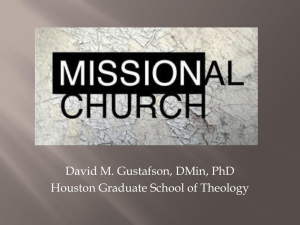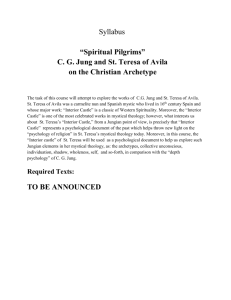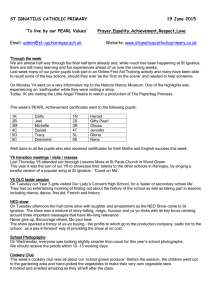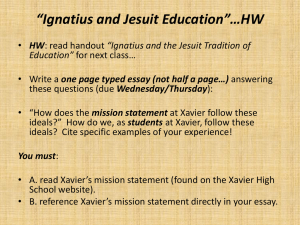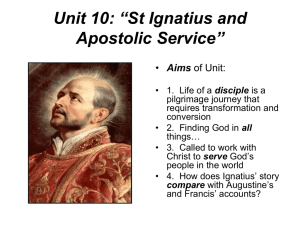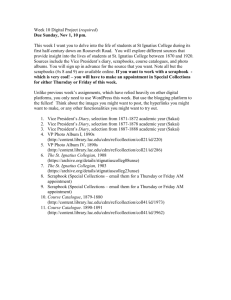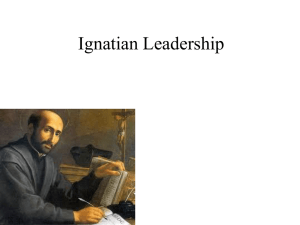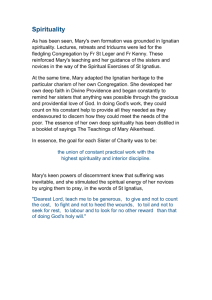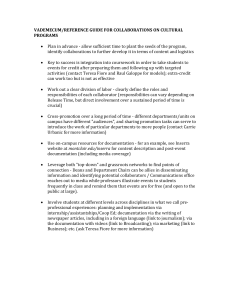Blackwell Companion to Christian Mysticism
advertisement
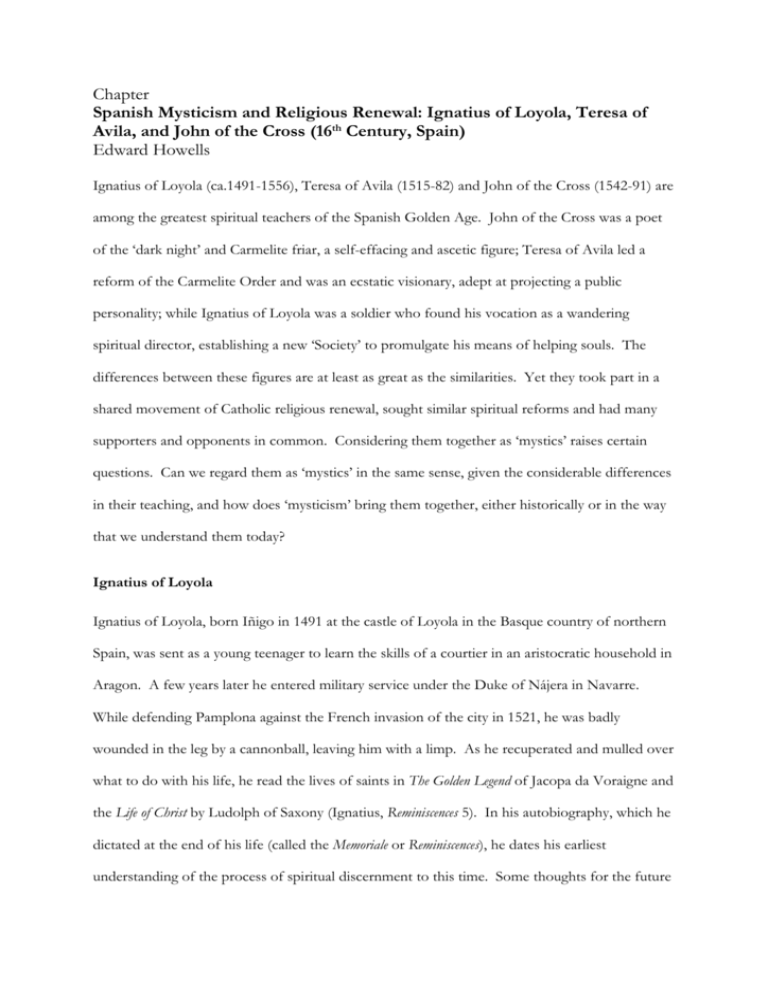
Chapter Spanish Mysticism and Religious Renewal: Ignatius of Loyola, Teresa of Avila, and John of the Cross (16th Century, Spain) Edward Howells Ignatius of Loyola (ca.1491-1556), Teresa of Avila (1515-82) and John of the Cross (1542-91) are among the greatest spiritual teachers of the Spanish Golden Age. John of the Cross was a poet of the ‘dark night’ and Carmelite friar, a self-effacing and ascetic figure; Teresa of Avila led a reform of the Carmelite Order and was an ecstatic visionary, adept at projecting a public personality; while Ignatius of Loyola was a soldier who found his vocation as a wandering spiritual director, establishing a new ‘Society’ to promulgate his means of helping souls. The differences between these figures are at least as great as the similarities. Yet they took part in a shared movement of Catholic religious renewal, sought similar spiritual reforms and had many supporters and opponents in common. Considering them together as ‘mystics’ raises certain questions. Can we regard them as ‘mystics’ in the same sense, given the considerable differences in their teaching, and how does ‘mysticism’ bring them together, either historically or in the way that we understand them today? Ignatius of Loyola Ignatius of Loyola, born Iñigo in 1491 at the castle of Loyola in the Basque country of northern Spain, was sent as a young teenager to learn the skills of a courtier in an aristocratic household in Aragon. A few years later he entered military service under the Duke of Nájera in Navarre. While defending Pamplona against the French invasion of the city in 1521, he was badly wounded in the leg by a cannonball, leaving him with a limp. As he recuperated and mulled over what to do with his life, he read the lives of saints in The Golden Legend of Jacopa da Voraigne and the Life of Christ by Ludolph of Saxony (Ignatius, Reminiscences 5). In his autobiography, which he dictated at the end of his life (called the Memoriale or Reminiscences), he dates his earliest understanding of the process of spiritual discernment to this time. Some thoughts for the future 2 left him dry and discontented, while others he could take delight in, so that ‘little by little [he was] coming to know the difference in kind of spirits that were stirring: the one from the devil, and the other from God’ (Reminiscences 8, p. 15). Ignatius set out on a life in emulation of the saints, especially St. Francis and St. Dominic, with a pilgrimage to Jerusalem as a poor beggar. He began with a period of retreat for a year at a Dominican monastery in Manresa (Spain), where he engaged in prayer and fasting. Here he encountered an inner aridity and trouble with ‘scruples’—an obsession with minor faults in the spiritual life—leading to suicidal thoughts. At his confessor’s command he ended his fast, but only when he identified certain feelings of disgust in himself at his ascetic regimen, and discerned them as coming from God, was he freed from his predicament (Reminiscences 17-25). Ignatius saw a breakthrough in this change, because now ‘God was dealing with him in the same way as a schoolteacher deals with a child, teaching him’ (Reminiscences 27, p. 25)—that is, directly and in person. He started to receive visions of the Trinity, the humanity of Christ and Our Lady (Mary), which gave him ‘much relish and consolation’ and ‘clarity of understanding’. He said that as a result his faith was strong enough to die for, on the basis of what he had seen with his ‘interior eyes’ (Reminiscences 28-30, pp. 26-27). This was a mystical turn, in line with understandings of mystical theology at the time—similar to both Teresa of Avila and John of the Cross—in that he was shifting from an exterior grasp of a spirituality that he wanted to emulate to an interior experience of God’s teaching as directly given to him. His view that God was teaching him without books or even the mediation of scripture reflected the ‘unmediated’ character ascribed to mystical theology. Yet he did not develop his mysticism in the manner of Teresa of Avila and John of the Cross, as we shall see. After Manresa, Ignatius continued his pilgrimage to Jerusalem, but because of the war with the Turks he was unable to establish a ministry there and had to return home. Gradually, he found that he was developing a skill in giving spiritual direction in conversation with individuals that he met on the way, which could be practised anywhere. This was the origin of 3 his Spiritual Exercises. In these early days, the mystical interiority that motivated his teaching caused him considerable difficulty with both church and state authorities. His later status as the founder of the Society of Jesus, or Jesuits, and the rapid growth and success of the Society, belies the frailty of his work in this period. Ignatius wanted the Jesuits to be able to wander freely, without the boundaries of monastic enclosure and the liturgical Hours kept by other religious orders, but this and the nature of his teaching brought opposition (as discussed further below) (O’Malley 6). Matters came to a head when he moved to Rome. The opposition was so strong that he found it necessary to seek the intervention of the Pope, who had earlier expressed support (Ignatius, Reminiscences 98; O’Malley 33). The Pope put in place a legal process, and formal approval of the new Society by the Holy See followed swiftly, in 1540. Thus, the Jesuits came under the Pope’s direct authority, and were given a vital role in the work of the Catholic Reformation, in re-missionising the Catholic world as well as in missions overseas, in controversy with Protestants, and most of all in boys’ education and founding schools. Ignatius became the superior general of the new Society and spent the rest of his life in Rome, managing the growth of the Society around Europe and overseas and bringing the Exercises to completion in 1548. He wrote Constitutions for the Society and numerous letters—which indicate his skills in managing people and dealing with those in power—as well as the Spiritual Diary and autobiography already mentioned. He died in 1556. Ignatius of Loyola’s Spiritual Exercises The Spiritual Exercises were written primarily for Jesuits in formation, to help them come to a decision about their ministry. This conditions the type of process involved: it is aimed at sifting motivations and reaching a major life choice in a short space of time. The Exercises are structured in four ‘weeks’, making a thirty-day retreat. The first week is concerned with the consideration of sins in order to reach a state of detachment and dependence on God. Ignatius sets out, in the ‘Principle and Foundation’ of the first week, his central notion of ‘indifference’. 4 The aim is to establish a sense of indifference in relation to the life choices and possibilities that face us—excepting those that are evil and thus under a ‘prohibition’—so that we are able to choose the end for which we are created, which Ignatius summarises here and repeatedly as ‘to praise, reverence and serve God Our Lord, and by doing so to save one’s soul’ (Exx 23, p. 289; also Exx 15, 179). Frequently, Ignatius links ‘indifference’ to the willingness to follow Christ in poverty, in reaction to what he saw as the corruption of spiritual motivation through power, wealth and status (e.g., Exx 155, 167). The second week focuses on the life of Christ up to Palm Sunday, and here Ignatius returns to the theme of poverty. In the meditation on Two Standards—which asks us to imagine service of ‘Lucifer, the deadly enemy of human nature’ as compared with ‘Christ our commander’—the one is identified with riches, honour and pride, and the other with poverty, insults and humility (Exx 136, p. 310; Exx 142, 146, 147). By giving up the desire for riches, honour and pride, imaginatively, a complete dependence on God and acceptance of what God wills is engendered. This is the key to freedom from disordered attachments and thus for clear decisions to be made about action in service of God. It sets the stage for making an ‘election’. By ‘election’, Ignatius means a significant life choice—for instance a decision about a religious vocation or career—but any choice requiring careful discernment is included (Exx 171, 178, 189). Ignatius’ guidelines on discernment, including the method of consolation and desolation, are given here (Exx 175-188; 316-7, 328-336). Discernment involves investigating the reactions of the heart to different possible courses of action. The decision, once arrived at, is offered to God for confirmation, and then is brought into a testing process that continues into the third and fourth weeks. In the third week, the exercises dwell on the passion of Christ, and in the fourth week on the resurrection and ascension. The imaginative method employed in individual meditations lies at the heart of the Exercises. Each exercise consists of a scene, either from scripture (mostly the Gospels) or using a doctrinal theme, which is intended to provoke a response, by bringing the one who meditates on 5 it into a felt relationship with the divine person involved. The exercise begins with a ‘composition’, that is, a putting together of a story as a mental picture. The use of the imagination is encouraged—Ignatius speaks of ‘bringing the five senses to bear’—so that one can develop one’s interactions within the scene, involving ‘the intimate feeling and relishing of things’ and an attitude of devotion, which engages the will and emotions (Exx 121, p. 307; 122125; 2, p. 283). Ignatius would have learned this method from Ludolph of Saxony’s Life of Christ, but his originality lies in the way that he uses it to engage the individual’s motivations for deliberating particular courses of action in the world. As he commented, the Exercises were ‘all the best that I have been able to think out, experience and understand in this life, both for helping somebody to make the most of themselves, as also for being able to bring advantage, help and profit to many others’ (Letter 6:2, p. 139). They are intended not just for inner nourishment but also to give shape to active lives in practice. Nevertheless, there are limitations to the Exercises, both in accessibility and scope. They are written for directors in the manner of a manual, with the assumption that they will be given in spoken form. Much is left to the discretion of the director in relation to the individual, such as which meditations are to be used and for how long. This means that their transformative potential is obscure to the general reader and they have little value outside the retreat or guided prayer context. Further, being written primarily for Jesuits approaching a major decision about their ministry, they do not address all the movements of the spiritual life and are notably silent on the subject of mystical theology and union with God (Houdek 26-34). It is here that the question of their ‘mystical’ character arises. Ignatian Mysticism? Accounts of Ignatius’ mysticism today focus on three elements: his experience at Manresa, his trinitarian prayer, and the distinctively Ignatian notion of ‘finding God in all things’, which led his followers to regard him as a ‘contemplative in action’ (Endean 2001, 78). It was not until the 6 early twentieth century that Ignatius’ autobiography and Spiritual Diary came to popular attention (‘Introduction’, Personal Writings, 8). Before this, Ignatius had not been widely regarded as a mystic. Henri Brémond, for instance, author of the great Literary History of Religious Thought in France, who trained as a Jesuit, saw Ignatius at first as a non-mystical figure, concerned with action as opposed to contemplation. Only when he read the autobiography and Spiritual Diary in the late 1920s did he change his mind, proclaiming Ignatius to be ‘the great mystic, so original as to be beyond imitation’ (Salin 73). The autobiography, as already mentioned, reports numerous visions. Ignatius’ Spiritual Diary details his experiences and deliberations in prayer over a six week period, including trinitarian visions of being taken before the Father, being placed with the Son, and seeing and feeling the Holy Spirit (Spiritual Diary I.7, 10, 12, 22; etc). Hugo Rahner, brother of the more famous Karl, makes an analysis of this inner trinitarian vision in which he seeks to show that it is central to the whole of Ignatius’ thought, including the Spiritual Exercises, and that it is truly mystical. In a study of the vision that Ignatius received on entering Rome shortly before founding the Society of Jesus, at La Storta, he spells out this quality (Rahner 1979, discussed by Endean 2001: 77-84). Ignatius, he says, sees everything in creation at the level of the trinitarian source: Ignatius is able to ‘see all together everything that is created—all that is outside God—from God’s side’—‘from the standpoint of the Trinitarian God’ (Rahner 73, 7980). Thus, when Ignatius speaks of seeing or finding God in all things, he means it in the sense of seeing all things at the level of their source, flowing directly from the Trinity. Karl Rahner took up his brother Hugo’s line of thinking about Ignatian mysticism, similarly regarding it as an immediate awareness of the life of the Trinity within creation (Endean (2001) 84-98). Is this mystical reading of Ignatius’ ‘finding God in all things’ justified? Brémond’s early opposition between mysticism, on the one hand, and action on the other hand, needs some consideration. Ignatius promotes an active spirituality of engagement in the world, with little time for withdrawal and solitude. He says that the Jesuits are different from the enclosed religious who spend many hours a day in solitary prayer (Letter 23:46-48). Commentators 7 continue to contrast Ignatian spirituality with mysticism on the grounds that it is primarily active rather than passive (Jalics 25-42). This contrast has some support from the mystical tradition, in that many mystics mark the shift to contemplation with an end to outward activity and discursive mental activity. In the apophatic tradition, there is the view that contemplation is imageless and silent, in contrast to image-filled or word-filled cataphatic prayer (Egan 700-704). But the contrast cannot be sustained. Theoretically, a moment’s reflection indicates that there is no human state that is wholly inactive. Contemplation is a form of human activity, whatever else it is. Historically, the Jesuits were by no means the first to attempt to be ‘contemplative in action’, departing from the monastic model of withdrawal from the world—this was the intention of the Augustinian canons and the mendicant friars before them, too. Ignatius took the view, uncontroversial in this context, that it was possible to be in immediate communication with God in prayer while active in the world, and no less so because one was active (Letter 23:53). The fact that Ignatian spirituality is active is not a sufficient reason for contrasting it with mysticism. Ignatius’ notion of ‘finding God in all things’ appears frequently in his writings. In the Exercises, for instance, he says that in spiritual consolation the soul becomes ‘inflamed with love of her Creator’ so that ‘there is no created thing on the face of the earth that we can love in itself, but we love it only in the Creator of all things’ (Exx 316, pp. 348-349, my emphasis). Similarly, in a letter to Francis Borgia, one of the first Jesuits, Ignatius says, ‘when persons go out of themselves and enter into their Creator and Lord, they enjoy continuous instruction, attention and consolation; they are aware how the fullness of our eternal God dwells in all created things’ (Letter 13:2, p. 161). Ignatius appears to be saying not merely that God can be felt through creation, instrumentally and remotely, but that the soul has an immediate participation in God’s own presence in creation. The soul sees creation ‘in God’, that is, from God’s perspective. The distinction is important, because it is one that mystical writers in Ignatius’ day—such as Teresa of Avila and John of the Cross, as we shall see—used to distinguish mystical apprehensions of God from the non-mystical. The distinction hangs on whether God’s presence is felt by a 8 process of inference from other things in creation (that is, ‘remotely’), or whether it is felt immediately, by sharing in God’s own relation to creation. This explains Hugo Rahner’s stress on the fact that Ignatius finds God in all things by seeing creation ‘from God’s side’. On this interpretation, Ignatius sees creation not merely as a means to God, but as God sees it, from within the divine view, at the source of creation, ‘in’ God. The distinction is not developed at any length by Ignatius, but it is sufficiently present to be asserted, and once found, can be regarded as central to his thought as a whole. In the light of his visions, it makes good sense to read the Exercises in this way, as having a mystical centre, and this reading also ties up with the proclamation by Ignatius’ close followers that he was a ‘contemplative in action’. The Exercises are set up in a way designed to encourage such an immediate relation between the individual and God. Ignatius’ initial ‘annotations’ ask the director to ‘leave the Creator to work directly with the creature, and the creature with the Creator and Lord’ (Exx 15, p. 286). Likewise, his emphasis on poverty and on imaginatively choosing ‘poverty with Christ poor’ is, as we have seen, intended to free the person from competing attachments so that they can relate to God simply and directly (Exx 167, p. 315). Commentators see in the Exercises a process of progressive simplification in prayer, where meditation works to make the soul increasingly open to God. This contrasts with a view of meditation as something that stands between the soul and God. Ignatian meditation is designed to reduce mediation, to bring the soul into immediate contact with God, rather than to add something in between, and this is why it leads to the mystical goal of ‘contemplation in action’ (e.g., Demoustier 18-22; Endean (2002) 81-82; Sudbrack 97-99; Houdek 32). Why, then, does Ignatius use so little of the language of mysticism? Bernard McGinn argues that we must understand mysticism not just as a type of experience or consciousness, of an immediate kind, but also as having specific linguistic forms and key terms, on account of its historical situation in texts and language (McGinn 1998: 13-21). Ignatius’ lack of reference to the language of mysticism, as it is found in other mystical writers of the time such as Teresa of Avila 9 and John of the Cross, is then more serious, perhaps indicating a deliberate decision to situate the Exercises outside the mystical tradition. For instance, as Joseph de Guibert has noted, there is ‘the complete absence of what could be called the “nuptial” aspect of mystical union’ in Ignatius (de Guibert 55). Ignatius scarcely makes use of the language of the Song of Songs, developed in the bridal or nuptial tradition of mysticism. Other major parts of the mystical tradition are similarly lacking, such as the ‘depth’ language associated with the Rhineland mystics, and the apophatic language of Dionysius the Areopagite. These were prominent forms of mysticism in Ignatius’ day and readily available to him, but he avoided them. In the Exercises, the most surprising omission is the lack of ‘union’ language. Ignatius hints at the traditional threefold structure of the mystical itinerary, referring to the first week as the ‘purgative way’ and the second week as the ‘illuminative way’ (Exx 10). But he does not mention the ‘unitive way’. Some commentators assume that the unitive way must apply to the third and fourth weeks, by implication—and this was the view put by Ignatius’ follower Jerónimo Nadal (O’Malley 48)—while others find it in the second week, as part of the ‘election’ (Robert 100-112). Or, as still others aver, could the unitive way simply be beyond the scope of the Exercises (Brémond 1928-1936; Jalics 2002)? This last interpretation is the least acceptable. To exclude union altogether would be to rule out the element of immediacy between the soul and God that I have been arguing for as central to Ignatius’ approach in the Exercises. Rather, union is best seen as implicit in the entire direction of the text and as its goal. It is reasonable to see union as present, at least incipiently, in the rules for making an election in the second week, and as coming to the soul’s explicit awareness, potentially, in the third and fourth weeks. Why Ignatius chose not to use the term is, then, obscure and must be put down to other factors. Perhaps he relied on good directors to manage mystical developments; or, after his early experience of anti-mystical opponents, he may have judged that the success of the Exercises would be compromised by using the common language of mysticism. 10 Teresa of Avila Teresa of Avila was born a generation after Ignatius, in 1515, in Ávila (Spain). Her father, Don Alonso Sánchez de Cepeda, was a businessman and cloth merchant. It is now known that her paternal grandfather had forcibly converted from Judaism after being accused of ‘apostasy’— practising Judaism in private—in Toledo in 1485. He moved to Ávila where he purchased a minor aristocratic title, no doubt to help cover his past. Teresa mentions nothing of this, but the fact that she belonged to a ‘new Christian’ (converso, ‘convert’) family helps to explain her later reaction against the inequalities of wealth, rank and status that affected her religious Order (Williams 11). Teresa entered the Carmelite monastery of the Incarnation in Ávila at the age of twenty. She was a voracious reader of spiritual literature and, while suffering from an illness as a young nun, mentions that she first experienced ‘union’ after reading Francisco de Osuna’s Third Spiritual Alphabet, which taught her the method of ‘recollection’ (recogimiento) (Life 4:7). Later, however, she says that she lost her way in prayer for nearly twenty years, and even gave it up for a time (Life 8:2). At the age of 39, her desire for God was rekindled by seeing a new statue in the monastery, of Christ in agony. She broke down in tears, feeling how poorly she ‘thanked him for those wounds’ (Life 9:1, Vol. 1, p. 101). Significant changes followed, known as her ‘second conversion’. She started to understand, through meditating on the ‘scene in the garden’ (of Gethsemane), where Jesus is in need and cries out in anguish, that the incarnation offered her not subordination but a kind of equality: not only did she need God, but God needed her. She felt a new sense of acceptance by God (Life 9:4). She discovered that ‘mental prayer’ – that is, informal, personal prayer – was ‘nothing other than an intimate sharing between friends’, in which, as Ignatius also found, she could be directly taught by God, and reach an accord of wills as between friends (Life 8:5, vol. 1, p. 94). This gave her a new desire to spend time alone with Christ in prayer. Not unlike Ignatius, Teresa started to receive extraordinary visions and ecstasies. They brought her into direct contact with Christ and the inner life of the Trinity. But Teresa is 11 unusual, even for her time, for the detail with which she recorded and classified these experiences. They are the main topic of both her Life (1562-65) and her spiritual diary, called the Spiritual Testimonies (1560-81), and occupy a significant portion of her other major works – the Way of Perfection (1566-69), Meditations on the Song of Songs (1566-75), and the Interior Castle (1577). They are the basis on which Teresa asserts her authority to teach and to write. In 1559, an Index of forbidden books was published by the Inquisitor Fernando de Valdés, which removed many of the books on prayer read by nuns. In response, Teresa says that, ‘the Lord said to me, “Don’t be sad, for I shall give you a living book”.’ She regarded her experiences of prayer as the ‘living book’ for her teaching, which would replace the banned books (Life 26:5, vol. 1, p. 226; Ahlgren 39-42). Teresa’s ‘second conversion’ and renewed desire for prayer led her to seek a reform of her Order. As Jodi Bilinkoff has shown, Teresa’s monastery of the Incarnation did not provide an atmosphere conducive to prayer, contrary to the Order’s eremitical origins on Mount Carmel. The nuns were unable to pray because they were distracted by the daily visits of relatives and friends and by the gossip of the town. Powerful local families who had a stake in the monastery through their gifts of endowment were effectively in charge, rather than the nuns. There were internal divisions between the nuns, caused by differences of social status, with nuns bringing family wealth, servants and titles into the monastery. Teresa sought to remove these abuses. Not being able to take on the powerful forces at work in her own monastery, she founded a new, smaller house in the town, called St. Joseph’s. St. Joseph’s returned the Order to strict enclosure, as well as to poverty and living on alms (Bilinkoff 123-137). In the Way of Perfection, Teresa describes the new way of life. She adverts to her desire to oppose the Protestant threat of the ‘Lutherans’ (Way 1:2)—showing her wider reforming intentions—but her main focus is on giving the nuns space for withdrawal, in a friendly, well-ordered and enclosed monastery, so that they can pursue contemplation and attain a full sense of God’s interior presence in mystical 12 union. This became the model for her reform and for the further houses that she founded in the years before her death in 1582. Teresa’s Opponents and the Jesuits Teresa was denounced to the Inquisition at least six times in her life (Ahlgren 32, 45-66). There was a climate of opposition to ‘spiritual’ teaching in Spain that gathered pace during the course of the sixteenth century (Ahlgren 6-31). Ignatius had faced similar difficulties. While travelling through Spain, Ignatius and his companions had been accused by the Inquisition of being alumbrados on account of their ragged dress and preference for frequent communion. Alumbrado, meaning ‘illuminated one’, was a pejorative term for those who appeared to rely on direct inspiration for their teaching as opposed to the authority of the church, at a time of nervousness over Luther and the northern Reformation (Ahlgren 7-15; O’Malley 43-44). Ignatius and his companions were also questioned about their observance of the sabbath, possibly out of a concern that they were ‘judaizers’ or conversos (‘converts’), recalling the forced conversion of Jews in recent memory (such as of Teresa’s grandfather). They were ordered not to teach on matters of faith, because they were not ‘learned’ (Ignatius, Reminiscences 58-62). In reaction to the popular reforming and spiritual movements (groups known as espirituales, ‘spirituals’) that proliferated in the early sixteenth century, there was a growing insistence by the church authorities on ‘learning’ and being among the ‘learned’ (letrados) (Ahlgren 14). Teresa encountered the same opposition a generation later. She was repeatedly accused of alumbrado teaching (Ahlgren, 49-55). Her words against Lutherans and frequent protestations of appreciation for ‘learned’ confessors, as well as of obedience to the church authorities, show her navigating this opposition (Way1:2). The difference in Teresa’s case was that the accusations were more serious, because the climate of suspicion had gathered pace since Ignatius’ day, and more importantly, because she was a woman. Unlike Ignatius, she depended on her direct experience of God for her authority to 13 write and teach, and she could not acquire learning or seek ordination as a priest, as the Jesuits did, to make herself acceptable (Ahlgren, 21, 67-84). As Gillian Ahlgren and other scholars have argued, Teresa’s success was achieved only by arduous attempts over many years at managing her opponents, attracting support, and developing rhetorical methods of ‘subordination’ to male authority in her written teaching. Teresa’s relation to the Jesuits in Ávila illustrates her precarious relationship to authority. The first Jesuits arrived in Ávila in the early 1550s and were welcomed by the reforming party (Bilinkoff 88-95). Teresa’s new foundation of St. Joseph’s caused divisions, setting the reforming party against the rest of the town and giving rise to considerably animosity. Teresa looked to the Jesuits because, she says, they understood her language of the soul and immediate experience of God’s Spirit (Life 23:16-18). She had three Jesuit confessors in the period between her second conversion and the foundation St. Joseph’s (Life 23:3). She also recounts two meetings with Ignatius’ close follower, Francis Borgia, who visited Ávila. At the first, Borgia reassured her that her experience in prayer was from the Spirit of God, but that she should always begin with meditation on an event from the Passion, and only if the Lord should then carry away her spirit should she not resist (Life 24:3). This was a vital vindication for Teresa at a time when others were accusing her of deception by the devil, and also shows the influence of the meditative method of Ignatius. At the second, Teresa discussed a state in prayer where she felt that the ‘active and contemplative lives are joined’ and ‘Mary and Martha walk together’. Borgia replied that ‘the experience was very possible, that it had happened to him’ (Way 31:5, p. 155). In Teresa’s last work, the story of her Foundations, she recounts many occasions on which the Jesuits helped her in battles with various authorities when making new foundations (Testimonies 58; Foundations 3:1; 15:1,4; 27:1; 29:4; 31:1). The well-known Jerónimo Martínez de Ripalda SJ, her confessor in Salamanca in 1573, became her first biographer after her death. These instances show that, in the ecclesial and political landscape of sixteenth century Spain, Teresa and the Jesuits were thrown together and had much in common. Both were identified as 14 among the espirituales and had many of the same reactionary opponents on town councils and in the church hierarchy. They shared the aim of renewing the life of interior prayer as the primary means to reform the Catholic church, and the Jesuits helped Teresa in her part in this movement. Teresa of Avila’s Interior Castle Teresa’s Interior Castle, written in 1577, twelve years after the Life and five years before her death, is her greatest attempt to systematise her teaching on prayer. She describes an interior journey of seven stages or ‘dwelling places’ (moradas, ‘mansions’ in older translations), moving from the exterior of the soul, symbolised as a castle, to the ‘centre’ where Christ dwells, as the king. In the centre the soul attains spiritual marriage or union with God (Castle 1.1:1-3). The soul, made in the image of God, appropriates its full God-likeness by growing inwardly in an intimate relationship of love with God. ‘Entering within’ is the first step, by reflecting on one’s relation to God, thinking of God’s greatness and of what this means for oneself as creature—that we are ‘capable of much more than we can imagine’ (Castle 1.1:5, p. 286; 2:8, p. 291). The relationship is given movement by the activity of ‘dealing in turn now with self and now with God’, against both sin and the ‘mud of fears, faintheartedness and cowardice’ which cause a ‘lack of freedom from ourselves’ (Castle 1.2:10-11, Vol. 2, p. 292.). This stage is called ‘the room of selfknowledge’ (Castle 1.2:8, p. 291), but self-knowledge here is to be contrasted with the modern sense of an inventory of strengths and weaknesses, meaning rather a dynamic, relational selfawareness of our source in God, in the sense given to the Western mystical tradition by Augustine. Teresa’s teaching in all her works on prayer is dominated by the shift to what she variously calls ‘supernatural’ or ‘mystical’ states, which in the Interior Castle begin in the fourth dwelling places. The initial sign is a new passivity and loss of control, a ‘flight’ or ‘suspension’ beyond one’s natural capabilities. Teresa pictures God as received here in the manner of a flow 15 of water – an image first introduced in her chapters on prayer in the Life—but now in the deep ‘centre’ of the soul, such that the soul is like a trough filled and ‘expanded’ to share in the very being of God, becoming God’s life (Castle 4.2:3-6; 3:9; Life 11-18). This immediate, mystical relation to God is contrasted with the ‘ingenuity and skill’ of meditative exercises, by which water is brought from far away through ‘aqueducts’ (Castle 4.2:3). Teresa does not oppose a return to meditation as the soul progresses, but as the interior of the soul ‘expands’ into a full awareness of union with God at the ‘centre’, meditative exercises become less necessary, and may no longer be possible (Castle 6.7:10-12; 7.2:3). An important development in the Interior Castle is that Teresa ceases to identify union with the ecstatic phenomena of ‘flights’, ‘raptures’ and so on, and hence with a loss of bodily activity, but sees these effects (if they are given) merely as signs of a deeper transformative process in which the whole soul is being renewed in the image of God, on its journey to an immediate union with God at the centre. In the seventh (and final) dwelling places, the water of union ‘overflows’, producing exterior virtuous works directly out of the interior union with God, thus joining contemplation to action: Mary and Martha now ‘work together’ in the soul and the soul goes out actively in good works. Thus, the possibility that she had discussed with Francis Borgia attains a crowning place in her teaching, as contemplation and action are joined in the final union. The intimate exchanges between the soul and God at the ‘centre’ of the castle, in the spiritual marriage (union), become the immediate source of the soul’s actions in the outside world. The soul gains a renewed agency while remaining in the interior union with God (Castle 7.1:5; 2:6; 3:12-13; 4:10; Howells 78-92). Teresa expresses the final union in christological and trinitarian terms. The soul joins Christ’s divine nature in the spiritual marriage by exchanging its human nature for his, and this is accompanied by an inner trinitarian vision, of understanding oneself within the company of Father, Son and Holy Spirit, and flowing out with the Persons into creation (Castle 7.1:6-7; 2:1-2; Testimonies 14). This echoes Hugo Rahner’s view of Ignatius, that he saw creation ‘from God’s side’ and ‘from the standpoint of the Trinitarian God’. But in Teresa this trinitarian act of seeing 16 is given a more extensive treatment, being placed at the summit of her mystical teaching and being analysed using a series of images and stages. Equally, on the topic of deliberation towards concrete actions, Teresa is less detailed than Ignatius. She asserts that the same ‘loving expressions’ that unite the soul with God at the centre of the soul flow outwards into actions in accordance with God’s will, but she does not say how this works in practice or in particular individual circumstances (Castle 7.1:5; 2:6). The emphasis of Teresa’s teaching is therefore different from Ignatius’s. Both give the mystical and trinitarian presence of God in the soul the central place, but Teresa expands this element throughout her work, while Ignatius attends to its practical outworking. John of the Cross John of the Cross was born in Fontiveros, Castile, in 1542, a generation after Teresa and twentyseven years her junior. Less is known about him than Teresa or Ignatius, because he was not a celebrated figure in his lifetime and wrote little about himself. His early years and upbringing were marked by poverty. His father, Gonzalo de Yepes, a dealer in silks, died when John was young, leaving John’s mother to keep her three boys by piece-work in weaving. She has been described as an ‘economic refugee’ (Thompson 2002: 29), moving the family first to Arévalo and then to Medina del Campo, a major trading centre, to find work. In Medina, John went to a free orphanage school for his elementary education and, in his teens, received a scholarship to attend the recently opened Jesuit college. There he gained a high quality education in classical literature, developing his skills in language and poetry, as well as a strong religious formation. He worked in a local hospital for the victims of syphilis to help pay for his keep. At the age of twenty he entered the Carmelite Order in Medina, and was sent to study at the University of Salamanca. He pursued the arts course for three years and took one further year of theology, but a meeting with Teresa of Avila caused him to cut short his studies, to join her in the Carmelite reform. 17 Given his academic abilities this was a surprising decision, indicating his desire for a more rigorous life of prayer. John was active in the rapid growth of the Carmelite reform, helping to set up new houses for friars and giving spiritual direction to nuns. But he became embroiled in the divisions that soon started to appear in Order between reformed (‘Discalced’) and unreformed (‘Calced’) houses, which were exacerbated by the failure of the Spanish monarchy and the Order’s authorities in Rome to coordinate their support. To keep the peace, the authorities tried to limit the involvement of the Discalced in Calced houses. Matters came to a head in Ávila, where both Discalced and Calced claimed authority over Teresa’s old monastery of the Incarnation. John, who had been acting as confessor to the nuns for the previous five years, was kidnapped and removed to the Calced house in Toledo. He was put in a tiny cell, in solitary confinement, and was taken out only once a week to face the ‘discipline’ of whipping. As Iain Matthew has commented, the psychological effect of being treated in this way by his religious brothers is likely to have been worse than the physical: it cut to the heart of his vow of obedience, and put in question his life’s work (Matthew 9-10). Teresa wrote that he would have received better treatment had he been captured by the Moors (Letter 208, cited Thompson (2002) 54, n. 97)! After nine months, however, John managed to escape, apparently by jumping out of the window and falling onto a ledge below, from which he made his way to the Discalced nuns in the city and safety. What John thought of his experience in prison is hard to tell, since he did not write about it. He went to work at the other end of the country, on the Discalced foundations in Andalusia. But he gives one clue in a letter, likening it to being ‘swallowed by the whale’— Jonah’s whale—which elsewhere he links, as it is linked in the Gospel, to the period between the crucifixion and the resurrection, when darkness and death hold sway but are about to be broken open by new life (Letter 1, cited Matthew 11; Night 2.6:1). It seems likely that he conceived his great work on the ‘dark night’, called the Ascent of Mount Carmel and Dark Night (Ascent-Night for 18 short), out of his sense of utter deprivation in prison. He intended it for those who ‘feel lost’ on the spiritual path, with no sense of spiritual satisfaction or consolation, in a suffering ‘worse than death’ (Ascent Prologue, 4-5, p. 71). Within the darkness, he finds that the soul has a hidden yet intense desire for God that can guide it to the light of mystical union. In 1580 the Order was formally divided into two branches by the Pope, to allow a peaceful coexistence. John rose quickly through the Discalced Order in Andalusia, becoming Provincial in 1585. But further ructions arose within the Discalced branch, from which John was again the loser. He was demoted to the position of Prior in Segovia in 1588, and in 1591 was chosen to lead a missionary expedition to Mexico, now aged 49. Before he took up this appointment, his life was cut short by an infection in his leg, from which he died in December of that year. John of the Cross’ ‘dark night’ John’s three major works, the Ascent of Mount Carmel and Dark Night, the Spiritual Canticle, and the Living Flame of Love, are conceived as commentaries on his poems. The poems contain his finest inspiration on spiritual themes, he says, which he then seeks to extend and develop in his commentaries (Canticle Prologue). The Ascent-Night is the most systematic of the works. John’s object is to chart the long process of purgation that precedes union. Purgation and illumination—darkness and light—are combined on the spiritual journey. He applies the benefit of hindsight, from the perspective of union, to find the seeds of union within the process of purgation (Ascent 2.4:8-5:11). Indeed, when illumination is mystical, he says, it is felt by the unreformed soul as dark and empty, because God exceeds the capacity of the soul and ‘blinds’ it, like looking at the sun, and because of the soul’s impurity, which obscures the light (e.g., Ascent 2.8:6; Night 2.5). Correctly discerned, however, this ‘dark illumination’ can be received as grace, so that, rather than running away from it or seeking to fill the emptiness with other things, 19 including misplaced spiritual exercises, the soul can begin to rest in the divine inflow and to recognise it as light (Night 1.9-10; 2.8:4). There is a notable difference here between John’s approach and Ignatius’ Exercises. For Ignatius, an important rule of discernment is to follow good feelings in relation to God, called ‘consolation’, as an indication of God’s guidance, while the opposite, called ‘desolation’, show us faults or test our patience and dependence on God, or point to the action of the evil spirit (Exx 316-7, 322). As Jules Toner says, Ignatius does not leave room for John’s dark night, which is the opposite of a positive spiritual experience. To use Ignatius’ rules in these circumstances would produce the wrong result, by pointing towards desolation rather than consolation and forcing the soul back to meditative exercises that John says should be left off in the most severe parts of the night (Toner 271-282; Night 1.9-10). But other commentators find room for greater agreement. They point out that Ignatius does not always regard consolation as an emotionally pleasant experience, and that in the third and fourth weeks, there comes a point when, as Philip Endean says, ‘activity and discursive meditation cease to satisfy’, and there is ‘confrontation with spiritual weaknesses hitherto unconscious’. There is then a ‘death of a sense of self centred on the ego’ in the third week, and ‘the finding of God’s abiding presence through and beyond searing loss’ in the fourth week, which has considerable similarities with the dark night (Endean 2000: 50). Valuable as this interpretation is, however, the most that can be said is that Ignatius hints in this direction, while saying very little in the Exercises overall about a dark night experience. The Ascent-Night is ordered by John into four ‘nights’, comprising a distinction between active and passive aspects and a further sub-division between the ‘senses’ and the ‘spirit’. But he frequently departs from this order and most of the work is structured instead using an exposition of faith, hope and love (Ascent Books 2 and 3). Adopting a correlation derived from Augustine, John applies faith to the intellect, hope to the memory, and love to the will (Ascent 2.6). To go forward in the ‘night’ by means of faith, hope and love is to receive an emptying of these 20 faculties—a sense of loss of the familiar things that one identifies with God’s presence—but then to be given new spiritual powers of intellect, memory and will, such that God’s deep being, which touches the soul in the soul’s ‘substance’ and ‘centre’, ceases to be dark and becomes recognisable as light. Thus, the emphasis is on how the mind is transformed by grace to be able to discern God’s mystical presence inwardly. John’s two other main works, the Spiritual Canticle and Living Flame of Love, begin with God’s trinitarian presence in the soul made in the image of God, moving in stages towards union with God at the centre, expressed in terms of the spiritual marriage of Bride and Bridegroom. The treatment of purgation and darkness is briefer in these works, though still present (Canticle 12:9-13:1; Flame 1:19-25). The immediate presence of God in union is developed as a trinitarian presence in which the soul ‘breathes’ the Holy Spirit within the life of the Trinity (Canticle 13:1112; 39:3-6; Flame 1:6; 3:82; 4:2-5, 17) and is able to see creation from the perspective of the divine ‘centre’ of all things, found in the ‘depth’ and ‘centre’ of the soul (Flame 1:9-13; Howells 47-50). At this point, there is also a joining of contemplation and action (Canticle 28:3-5; Flame 1:36). In these respects John’s Canticle and Flame are like Teresa’s Interior Castle, and John shares Teresa’s emphasis on the interior analysis of union. Also like Teresa, he merely asserts rather than works out the means by which concrete actions are deliberated and chosen in the state of union, in contrast to Ignatius. John recommends Teresa’s treatment of ‘raptures, ecstasies, and other elevations and flights of the soul’ in the Spiritual Canticle (Canticle 13:7, p. 460), but his overall attitude to special supernatural experiences is more negative. He is suspicious of such overwhelmingly positive feelings because they may blind the soul to God’s hidden presence (Ascent 2.7:11; 24:8-9). John is influenced partly by Dionysius the Areopagite, whose apophaticism allows him to juxtapose ‘darkness’ and ‘light’ dialectically rather than seeing them as simple opposites (Ascent 2.8:6; Night 2.5:3; Canticle 14&15:16; Flame 3:49; Howells 129-133). More influential, however, is his adoption of a late medieval sensibility of sharing in Christ’s suffering and ‘annihilation’ on the 21 cross, which he uses to give aridity and darkness Christological value (Ascent 2.7). The notion of the ‘wound’ of Christ, especially, links pain to a more positive sense of vulnerability or opening to God, leading to the transformation of the soul into mutual love in union (Canticle 1:16-19; 9:13; 13:2-9; 35:7; Flame 1:7-8; 2:1-14). Teresa does not give suffering with Christ such a systematic role. For her, Christ’s presence is positively felt, as delight, companionship and comfort, even though she pictures Christ’s suffering prominently in her visions. But it is not the case that Teresa and John disagree over the value of the humanity of Christ itself: both affirm the humanity of Christ as central, yet they identify it with different felt effects. Teresa associates it with positive feelings while John has a dialectical approach, including negative and positive feelings together (Howells 133-137). In this, Ignatius stands somewhere between John and Teresa. Like John, who sees the first signs of an explicit awareness of union in feelings of sharing the inward suffering of Christ on the cross, Ignatius values the feeling of dereliction and a sense of the inner poverty of Christ as vital parts of making a sound election or life-choice. Like Teresa, however, for the most part in the Exercises, he favours positive feelings. Conclusion Ignatius, Teresa and John share a view of ‘spiritual’ reform centred on the interior renewal of the soul in relation to God. Their teaching on prayer is directed at bringing the soul to an inward poverty (indifference, detachment, emptiness), where God can fill and teach the soul directly. This is directly connected to their understanding of mystical theology as a relation to God without intermediary, which allows the soul to relate to the world at the level of the trinitarian source of all things in God, rather than ‘remotely’ through creatures understood as outside or over against God. Ignatius’ accounts of his visions and the early development of his vocation suggest a mystical journey similar to that charted by Teresa and John. But his Exercises and mainstream teaching do not give space to questions of mystical theology and union in the way that the Carmelites do. He is concerned with a more practical deliberation of particular concrete 22 decisions. Yet these decisions are only authentic, for Ignatius, if they spring from an inner union with God in which God moves the will without any obstacle from our side. To ‘find God in all things’ according to Ignatius is to find oneself immediately sourced in God, flowing out of the inner relations of the Trinity, as Hugo Rahner says, and thus no longer in the grip of merely creaturely considerations. On this, there is a deep compatibility and agreement between the mysticism of these three figures. But we must recognise that Ignatius lacks the full articulation of union with God that we find in the two Carmelites; and they lack the tailoring of unitive action to the individual’s circumstances that is Ignatius’ forte. Bibliography Ahlgren, Gillian T. W. Teresa of Avila and the Politics of Sanctity. London: Cornell University Press, 1996. Bilinkoff, Jodi. The Avila of Saint Teresa: Religious Reform in a Sixteenth-Century City. London: Cornell University Press, 1989. Brémond, Henri. A literary history of religious thought in France from the wars of religion down to our own times (London: Society for Promoting Christian Knowledge, 1928-1936). Buckley, Michael J. “Ecclesial Mysticism in the Spiritual Exercises of Ignatius.” Theological Studies 56 (1995): 452-463. de Guibert, Joseph. The Jesuits: Their Spiritual Doctrine and Practice: a Historical Study. Chicago: Institute of Jesuit Sources, 1964. Demoustier, Adrien. “Ignatian Contemplation and the Contemplative Way.” The Way Supplement 103 (2002): 16-24 Egan, Harvey D. “Negative Way.” New Dictionary of Catholic Spirituality, pp. 700-704. Endean, Philip. “‘Our Lady’ and the Graces of the Fourth Week.” The Way Supplement 99 (2000): 44-60. ______. Karl Rahner and Ignatian Spirituality. Oxford: Oxford University Press, 2001. 23 ______. “The Concept of Ignatian Mysticism.” The Way Supplement 103 (2002): 77-86. Houdek, Frank J. “The Limitations of Ignatian Prayer.” Way Supplement 82 (1995): 26-34. Howells, Edward. John of the Cross and Teresa of Avila: Mystical Knowing and Selfhood. New York: Crossroad, 2002. Saint Ignatius of Loyola: Personal Writings. Transl. and ed. Joseph A. Munitiz and Philip Endean. London: Penguin Books, 1996. Jalics, Franz. “The Contemplative Phase of the Ignatian Exercises.” The Way Supplement 103 (2002): 25-42. [John of the Cross] The Collected Works of John of the Cross. Transl. and intro. Kieran Kavanaugh and Otilio Rodriguez. Washington D.C.: Institute of Carmelite Studies, 1979. Matthew, Iain. The Impact of God: Soundings from St John of the Cross. London: Hodder and Stoughton, 1995. McGinn, Bernard. “Quo Vadis? Reflections on the current study of mysticism.” Christian Spirituality Bulletin 6, no. 1 (1998): 13-21. O’Malley, John W. The First Jesuits. Cambridge, MA: Harvard University Press, 1993. Rahner, Hugo. The Vision of St. Ignatius in the Chapel of La Storta. 2nd ed., transl. Robert O. Brennan. Rome: CIS, 1979 (first published 1935). Robert, Sylvie. “Union with God in the Ignatian Election.” The Way Supplement 103 (2002): 100112. Salin, Dominique. “Methods for Sancho Panza: Henri Brémond and the Interpretation of the Ignatian Exercises.” The Way Supplement 103 (2002): 66-76. Sudbrack, Josef. “Finding God in All Things: Christian Contemplation and the Ignatian Exercises.” The Way Supplement 103 (2002): 87-99. [Teresa of Avila] The Collected Works of St Teresa of Avila. Transl. and intro. Kieran Kavanaugh and Otilio Rodriguez, 3 vols. Washington: Institute of Carmelite Studies, 1976-1985. Thompson, Colin. St. John of the Cross: Songs in the Night. London: SPCK, 2002. 24 Toner, Jules J. A Commentary on St. Ignatius’ Rules for the Discernment of Spirits. St. Louis: Institute of Jesuit Sources, 1982. Williams, Rowan. Teresa of Avila. London: Geoffrey Chapman, 1991.
